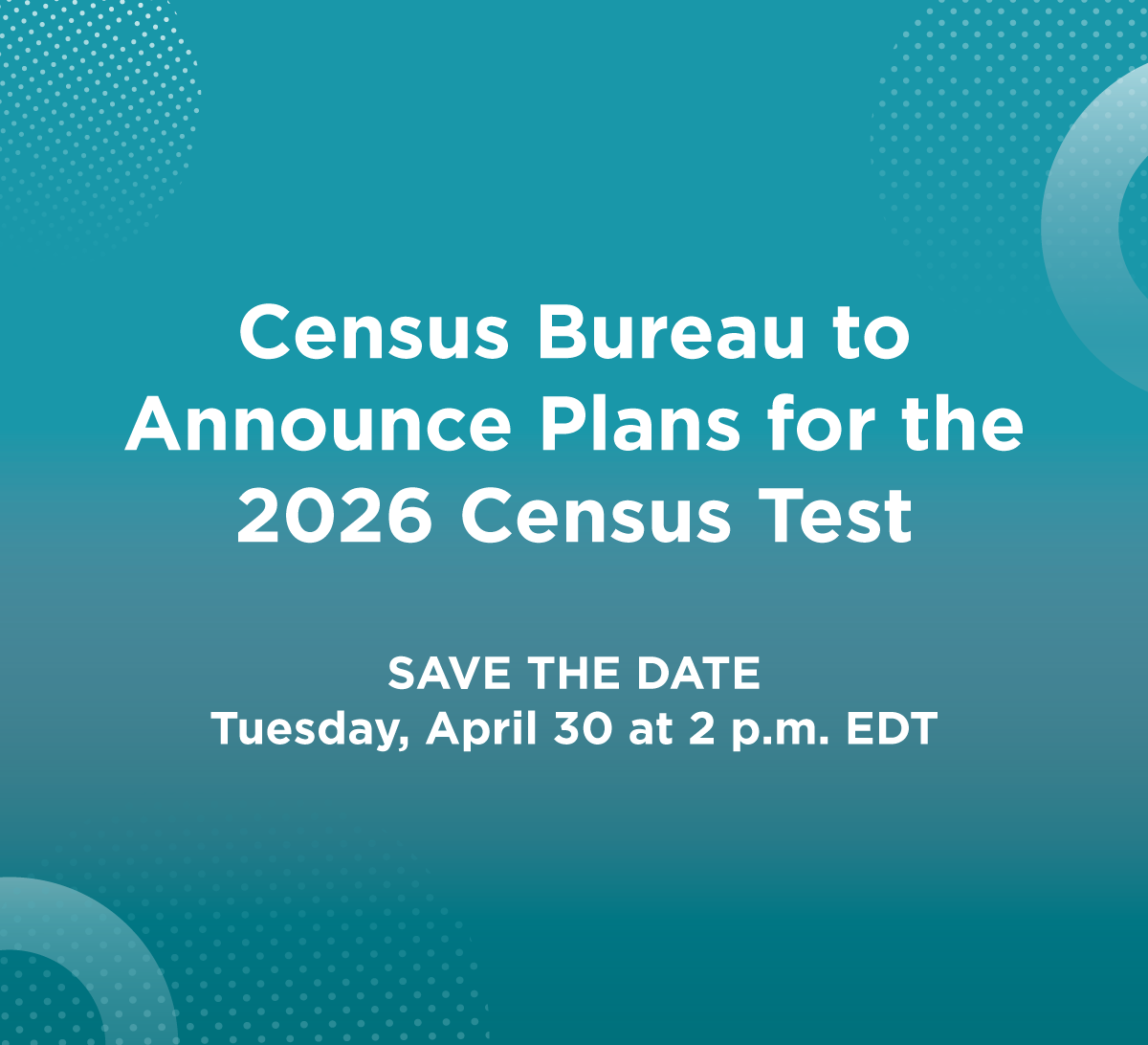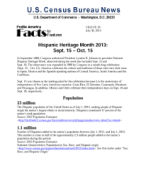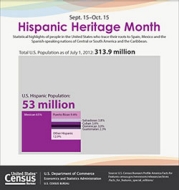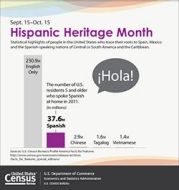Facts for Features: Hispanic Heritage Month 2013, Sept. 15 - Oct. 15
In September 1968, Congress authorized President Lyndon B. Johnson to proclaim National Hispanic Heritage Week, observed during the week that included Sept. 15 and Sept. 16. The observance was expanded in 1989 by Congress to a month long celebration (Sept. 15 - Oct. 15), America celebrates the culture and traditions of those who trace their roots to Spain, Mexico and the Spanish-speaking nations of Central America, South America and the Caribbean.
Sept. 15 was chosen as the starting point for the celebration because it is the anniversary of independence of five Latin American countries: Costa Rica, El Salvador, Guatemala, Honduras and Nicaragua. In addition, Mexico and Chile celebrate their independence days on Sept. 16 and Sept. 18, respectively.
Population
53 million
The Hispanic population of the United States as of July 1, 2012, making people of Hispanic origin the nation's largest ethnic or racial minority. Hispanics constituted 17 percent of the nation's total population.
Source: 2012 Population Estimates <factfinder2.census.gov/faces/tableservices/jsf/pages/productview.xhtml?src=bkmk>
1.1 million
Number of Hispanics added to the nation's population between July 1, 2011, and July 1, 2012. This number is close to half of the approximately 2.3 million people added to the nation's population during this period.
Source: 2012 Population Estimates
National Characteristics: Population by Sex, Race, and Hispanic origin <www.census.gov/popest/data/national/asrh/2012/>,
See first bullet under "Sex, Race, and Hispanic Origin"
2.2%
Percentage increase in the Hispanic population between 2011 and 2012. Source: 2012 Population Estimates National Characteristics: Population by Sex, Race, and Hispanic origin <www.census.gov/popest/data/national/asrh/2012/>, See first bullet under "Sex, Race, and Hispanic Origin"
128.8 million
The projected Hispanic population of the United States in 2060. According to this projection, the Hispanic population will constitute 31 percent of the nation's population by that date. Source: Population Projections <www.census.gov/newsroom/releases/archives/population/cb08-123.html>
2nd
Ranking of the size of the U.S. Hispanic population worldwide, as of 2010. Only Mexico (112 million) had a larger Hispanic population than the United States (50.5 million).
Source: International Data Base < www.census.gov/population/international/data/idb/informationGateway.php>
65%
The percentage of Hispanic-origin people in the United States who were of Mexican background in 2011. Another 9.4 percent were of Puerto Rican background, 3.8 percent Salvadoran, 3.6 percent Cuban, 3.0 percent Dominican and 2.3 percent Guatemalan. The remainder was of some other Central American, South American or other Hispanic/Latino origin.
Source: U.S. Census Bureau, 2011 American Community Survey: Table B03001 <factfinder2.census.gov/faces/tableservices/jsf/pages/productview.xhtml?fpt=table>
States and Counties
Florida
The state with the highest median age, 34, within the Hispanic population.
Source: 2012 Population Estimates
State Characteristics: Median Age by Race and Hispanic Origin <www.census.gov/popest/data/state/asrh/2012/index.html>
10 million
The estimated population for those of Hispanic-origin in Texas as of July 1, 2012.
Source: 2012 Population Estimates
State Characteristics: Population by Sex, Race, and Hispanic Origin <www.census.gov/popest/data/state/asrh/2012/index.html>
8
The number of states with a population of 1 million or more Hispanic residents in 2012 — Arizona, California, Colorado, Florida, Illinois, New Jersey, New York and Texas.
Source: 2012 Population Estimates
State Characteristics: Population by Race and Hispanic Origin <www.census.gov/popest/data/state/asrh/2012/index.html>
More than 50%
The percent of all the Hispanic population that lived in California, Florida, and Texas as of July 1, 2012.
Source: 2012 Population Estimates
State Characteristics: Population by Race and Hispanic Origin <www.census.gov/popest/data/state/asrh/2012/index.html>
47%
The percentage of New Mexico's population that was Hispanic as of July 1, 2012, the highest of any state.
Source: 2012 Population Estimates
State Characteristics: Population by Race and Hispanic Origin <www.census.gov/newsroom/archives/2013-pr/cb13-112.html>
14.5 million
The Hispanic population of California. This is the largest Hispanic population of any state as well as the largest numeric increase within the Hispanic population since July 1, 2011 (232,000).
Source: 2012 Population Estimates <www.census.gov/newsroom/archives/2013-pr/cb13-112.html>
4.8 million
The Hispanic population of Los Angeles County, Calif., in 2012. This is the highest of any county and the largest numeric increase since 2012 (55,000).
Source: 2012 Population Estimates <www.census.gov/newsroom/archives/2013-pr/cb13-112.html>
21
Number of states in which Hispanics were the largest minority group. These states were Arizona, California, Colorado, Connecticut, Florida, Idaho, Illinois, Iowa, Kansas, Massachusetts, Nebraska, Nevada, New Hampshire, New Jersey, New Mexico, Oregon, Rhode Island, Texas, Utah, Washington and Wyoming.
Source: American FactFinder: United States DP-1 <factfinder2.census.gov>
Families and Children
11.6 million
The number of Hispanic family households in the United States in 2012.
Source: Families and Living Arrangements: Table F1 <www.census.gov/hhes/families/data/cps2012.html>
62.3%
The percentage of Hispanic family households that were married couple households in 2012.
Source: Families and Living Arrangements: Table F1 <www.census.gov/hhes/families/data/cps2012.html>
60.4%
The percentage of Hispanic married-couple households that had children younger than 18 present in 2012.
Source: Families and Living Arrangements: Table F1 <www.census.gov/hhes/families/data/cps2012.html>
65.7%
Percentage of Hispanic children living with two parents in 2012.
Source: Families and Living Arrangements: Table C9 <www.census.gov/hhes/families/data/cps2012.html>
45.3%
Percentage of Hispanic married couples with children under 18 where both spouses were employed in 2012.
Source: Families and Living Arrangements: Table FG-1 <www.census.gov/hhes/families/data/cps2012.html>
Spanish Language
37.6 million
The number of U.S. residents 5 and older who spoke Spanish at home in 2011. This is a 117 percent increase since 1990 when it was 17.3 million. Those who hablan español en casa constituted 12.9 percent of U.S. residents 5 and older. More than half of these Spanish speakers spoke English "very well."
Source: U.S. Census Bureau, 2011 American Community Survey: Table B16001
<factfinder2.census.gov/faces/tableservices/jsf/pages/productview.xhtml?pid=ACS_11_1YR_B16001&prodType=table>
and Language Use in the United States: 2007 <www.census.gov/library/publications/2010/acs/acs-12.html>
74.3%
Percentage of Hispanics 5 and older who spoke Spanish at home in 2011.
Source: U.S. Census Bureau, 2011 American Community Survey: Table B16006
<factfinder2.census.gov/faces/tableservices/jsf/pages/productview.xhtml?pid=ACS_11_1YR_B16006&prodType=table>
Income, Poverty and Health Insurance
$38,624
The median income of Hispanic households in 2011.
Source: Income, Poverty, and Health Insurance Coverage in the United States: 2011, Table A
<www.census.gov/newsroom/releases/archives/income_wealth/cb12-172.html>
25.3%
The poverty rate among Hispanics in 2011, down from 26.5 percent in 2010.
Source: Income, Poverty, and Health Insurance Coverage in the United States: 2011, Table B
<www.census.gov/newsroom/releases/archives/income_wealth/cb12-172.html>
30.1%
The percentage of Hispanics who lacked health insurance in 2011.
Source: Income, Poverty, and Health Insurance Coverage in the United States: 2011, Table C-2
<www.census.gov/newsroom/releases/archives/income_wealth/cb12-172.html>
Education
63.2%
The percentage of Hispanics 25 and older that had at least a high school education in 2011.
Source: American Community Survey: 2011 Table S0201 (crossed with Hispanic origin)
<factfinder2.census.gov/faces/tableservices/jsf/pages/productview.xhtml?fpt=table>
13.2%
The percentage of the Hispanic population 25 and older with a bachelor's degree or higher in 2011.
Source: American Community Survey: 2011 Table S0201 (crossed with Hispanic origin)
<factfinder2.census.gov/faces/tableservices/jsf/pages/productview.xhtml?fpt=table>
3.7 million
The number of Hispanics 25 and older who had at least a bachelor's degree in 2011.
Source: American Community Survey: 2011 Table S0201 (crossed with Hispanic origin)
<factfinder2.census.gov/faces/tableservices/jsf/pages/productview.xhtml?fpt=table>
1.2 million
Number of Hispanics 25 and older with advanced degrees in 2011 (e.g., master's, professional, doctorate).
Source: American Community Survey: 2011 Table S0201 (crossed with Hispanic origin)
<factfinder2.census.gov/faces/tableservices/jsf/pages/productview.xhtml?fpt=table>
14.5%
Percentage of students (both undergraduate and graduate students) enrolled in college in 2011 who were Hispanic.
Source: School Enrollment Data Current Population Survey: October 2011, Table 1
<www.census.gov/hhes/school/data/cps/2011/tables.html>
22.5%
Percentage of elementary and high school students that were Hispanic in 2011.
Source: School Enrollment Data Current Population Survey: October 2011, Table 1
<www.census.gov/hhes/school/data/cps/2011/tables.html>
Foreign-Born
36.2%
Percent of the Hispanic population that was foreign-born in 2011.
Source: U.S. Census Bureau, 2011 American Community Survey, Table: S0201
<factfinder2.census.gov/faces/tableservices/jsf/pages/productview.xhtml?pid=ACS_09_1YR_S0201&prodType=table>
Jobs
67.4%
Percentage of Hispanics or Latinos 16 and older who were in the civilian labor force in 2011.
Source: U.S. Census Bureau, 2011 American Community Survey, Table: S0201 (Hispanic)
<factfinder2.census.gov/faces/tableservices/jsf/pages/productview.xhtml?pid=ACS_11_1YR_S0201&prodType=table>
19.2%
The percentage of civilian employed Hispanics or Latinos 16 and older who worked in management, business, science, and arts occupations in 2011.
Source: U.S. Census Bureau, 2011 American Community Survey, Table: S0201 (Hispanic)
<factfinder2.census.gov/bkmk/table/1.0/en/ACS/11_1YR/S0201//popgroup~400>
Voting
8.4%
The percentage of voters in the 2012 presidential election who were Hispanic. Hispanics comprised 7 percent of voters in 2010.
Source: News Release: Census Bureau Reports Hispanic Voter Turnout Reaches Record High for Congressional Election <www.census.gov/newsroom/releases/archives/voting/cb11-164.html> and Voting and Registration in the Election of November 2012: Table 2 <www.census.gov/hhes/www/socdemo/voting/publications/p20/2012/tables.html>
Serving our Country
1.2 million
The number of Hispanics or Latinos 18 and older who are veterans of the U.S. armed forces.
Source: U.S. Census Bureau, 2011 American Community Survey: Table B21001I
<factfinder2.census.gov/faces/tableservices/jsf/pages/productview.xhtml?pid=ACS_11_1YR_B21001I&prodType=table>
Businesses
Source for statements in this section: Statistics for All U.S. Firms by Industry, Gender, Ethnicity, and Race for the U.S., States, Metro Areas, Counties, and Places: 2007, Table SB0700CSA01
<factfinder2.census.gov/faces/tableservices/jsf/pages/productview.xhtml?pid=SBO_2007_00CSA01&prodType=table>
Data for 2012 are being collected.
2.3 million
The number of Hispanic-owned businesses in 2007, up 43.6 percent from 2002.
$350.7 billion
Receipts generated by Hispanic-owned businesses in 2007, up 58.0 percent from 2002.
23.7%
The percentage of businesses in New Mexico in 2007 that were Hispanic-owned, which led all states. Florida (22.4 percent) and Texas (20.7 percent) were runners-up.
The following is a list of observances typically covered by the Census Bureau’s Facts for Features series:
| Black (African American) History Month (February) Super Bowl Valentine's Day (Feb. 14) Women's History Month (March) Irish-American Heritage Month (March)/ St. Patrick's Day (March 17) Earth Day (April 22) Asian/Pacific American Heritage Month (May) Older Americans Month (May) Mother's Day Hurricane Season Begins (June 1) Father's Day |
The Fourth of July (July 4) Anniversary of Americans With Disabilities Act (July 26) Back to School (August) Labor Day Grandparents Day Hispanic Heritage Month (Sept. 15-Oct. 15) Unmarried and Single Americans Week Halloween (Oct. 31) American Indian/Alaska Native Heritage Month (November) Veterans Day (Nov. 11) Thanksgiving Day The Holiday Season (December) |
Editor’s note: The preceding data were collected from a variety of sources and may be subject to sampling variability and other sources of error. Facts for Features are customarily released about two months before an observance in order to accommodate magazine production timelines. Questions or comments should be directed to the Census Bureau’s Public Information Office: telephone: 301-763-3030; or e-mail: pio@census.gov.









